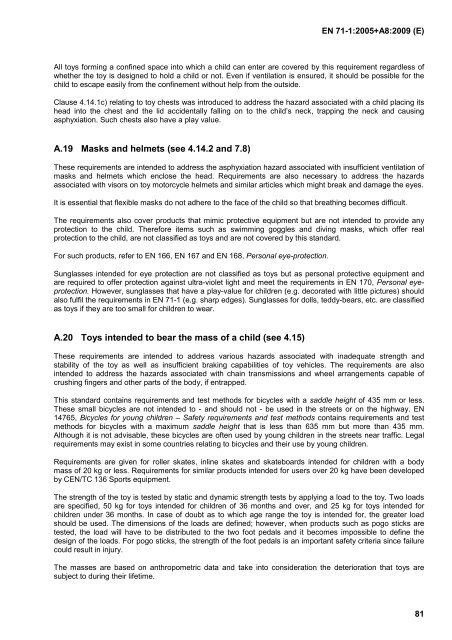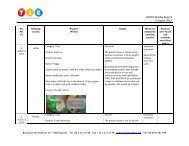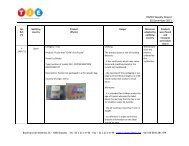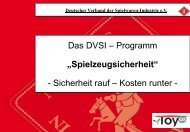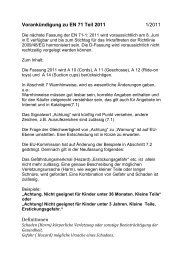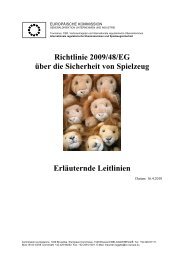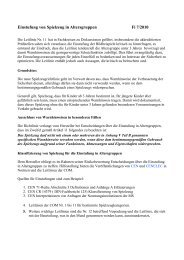You also want an ePaper? Increase the reach of your titles
YUMPU automatically turns print PDFs into web optimized ePapers that Google loves.
<strong>EN</strong> <strong>71</strong>-1:<strong>2005+</strong><strong>A8</strong>:2009 (E)<br />
All toys forming a confined space into which a child can enter are covered by this requirement regardless of<br />
whether the toy is designed to hold a child or not. Even if ventilation is ensured, it should be possible for the<br />
child to escape easily from the confinement without help from the outside.<br />
Clause 4.14.1c) relating to toy chests was introduced to address the hazard associated with a child placing its<br />
head into the chest and the lid accidentally falling on to the child’s neck, trapping the neck and causing<br />
asphyxiation. Such chests also have a play value.<br />
A.19 Masks and helmets (see 4.14.2 and 7.8)<br />
These requirements are intended to address the asphyxiation hazard associated with insufficient ventilation of<br />
masks and helmets which enclose the head. Requirements are also necessary to address the hazards<br />
associated with visors on toy motorcycle helmets and similar articles which might break and damage the eyes.<br />
It is essential that flexible masks do not adhere to the face of the child so that breathing becomes difficult.<br />
The requirements also cover products that mimic protective equipment but are not intended to provide any<br />
protection to the child. Therefore items such as swimming goggles and diving masks, which offer real<br />
protection to the child, are not classified as toys and are not covered by this standard.<br />
For such products, refer to <strong>EN</strong> 166, <strong>EN</strong> 167 and <strong>EN</strong> 168, Personal eye-protection.<br />
Sunglasses intended for eye protection are not classified as toys but as personal protective equipment and<br />
are required to offer protection against ultra-violet light and meet the requirements in <strong>EN</strong> 170, Personal eyeprotection.<br />
However, sunglasses that have a play-value for children (e.g. decorated with little pictures) should<br />
also fulfil the requirements in <strong>EN</strong> <strong>71</strong>-1 (e.g. sharp edges). Sunglasses for dolls, teddy-bears, etc. are classified<br />
as toys if they are too small for children to wear.<br />
A.20 Toys intended to bear the mass of a child (see 4.15)<br />
These requirements are intended to address various hazards associated with inadequate strength and<br />
stability of the toy as well as insufficient braking capabilities of toy vehicles. The requirements are also<br />
intended to address the hazards associated with chain transmissions and wheel arrangements capable of<br />
crushing fingers and other parts of the body, if entrapped.<br />
This standard contains requirements and test methods for bicycles with a saddle height of 435 mm or less.<br />
These small bicycles are not intended to - and should not - be used in the streets or on the highway. <strong>EN</strong><br />
14765, Bicycles for young children – Safety requirements and test methods contains requirements and test<br />
methods for bicycles with a maximum saddle height that is less than 635 mm but more than 435 mm.<br />
Although it is not advisable, these bicycles are often used by young children in the streets near traffic. Legal<br />
requirements may exist in some countries relating to bicycles and their use by young children.<br />
Requirements are given for roller skates, inline skates and skateboards intended for children with a body<br />
mass of 20 kg or less. Requirements for similar products intended for users over 20 kg have been developed<br />
by C<strong>EN</strong>/TC 136 Sports equipment.<br />
The strength of the toy is tested by static and dynamic strength tests by applying a load to the toy. Two loads<br />
are specified, 50 kg for toys intended for children of 36 months and over, and 25 kg for toys intended for<br />
children under 36 months. In case of doubt as to which age range the toy is intended for, the greater load<br />
should be used. The dimensions of the loads are defined; however, when products such as pogo sticks are<br />
tested, the load will have to be distributed to the two foot pedals and it becomes impossible to define the<br />
design of the loads. For pogo sticks, the strength of the foot pedals is an important safety criteria since failure<br />
could result in injury.<br />
The masses are based on anthropometric data and take into consideration the deterioration that toys are<br />
subject to during their lifetime.<br />
81


